► 7-seater electric cars rated
► Choice of SUVs and van-based MPVs
► Variety of brands and price points on offer
Not so long ago, if you were shopping for a decent electric car but needed seven seats, you’d have been pretty much out of luck – but now we’re happy to say these are the best seven-seater electric cars you can buy. That’s right: in 2025, there’s now enough choice of electric seven-seater cars we can give you advice about the best ones.
The growing number is being driven by demand, changing legislation, advancing technology and falling costs – plus the small but growing trend for luxury people moving. So while brands such as Vauxhall and Citroen have expedited seven-seat electric car development and deployment by bolting seats into the rear of their electric vans, others are aiming high with premium-grade products and chunky price tags.
The Mercedes EQV and even the Kia EV9 are great examples of this new breed of practical, versatile battery-powered family-friendly vehicles. Read on for our list of the best available in the UK today…
Best 7-seater electric cars at a glance:
Keep reading for CAR magazine’s full expert list of the best seven-seater EVs on sale in the UK today, covering SUVs, MPVs and vans. Alternatively, if you’re not quite ready to go fully electric, we have a list of the best seven-seater hybrids as well.
Best seven-seater electric cars 2025
Kia EV9
Best for: modern tech, cool looks and a long range
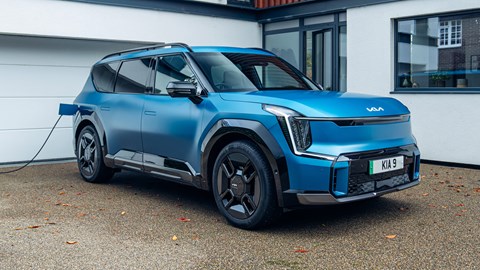
Pros: Big battery delivers lots of driving range, plenty of passenger space, premium feel
Cons: Not an exciting car, nor a cheap one (as Kias used to be…)
Kia’s bold moves in the electric car world continue with the EV9. This is a large, all-electric SUV that not only looks attractive on the outside but actually feels properly premium on the inside. It also comes with a huge 99.8kWh battery pack, good for a WLTP claimed driving range of 349 miles per charge if you opt for the 200bhp single-motor rear-wheel drive powertrain. Alternatively, the twin-motor variant produces 379bhp – enough action to propel you and six passengers from 0-62mph in a mind-boggling 5.3sec.
The charging is pretty fast as well. Using the same 800-volt/350kW capability as the Kia EV6, a 10-80 per cent top-up takes as little as 24 minutes. Only got 15 minutes to spare? That should still give you an extra 136 miles of range, in the right circumstances. While the driving experience is far from thrilling, it is polished. All told, it’s a Kia that feels worth the £65k minimum asking price.
For a more in-depth look, read our full Kia EV9 review
Mercedes EQB
Best for: those seeking a mix of compact and premium EV
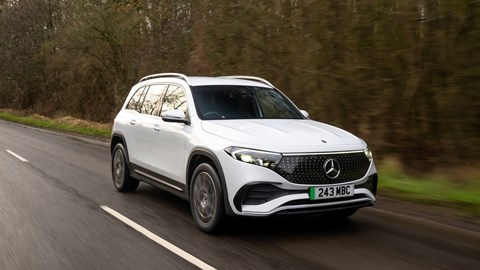
Pros: Small for a 7-seater, decent driving range, premium detailing
Cons: Leaden, roly-poly driving experience
The Mercedes-Benz EQB is one of the more sensible seven-seater electric cars here. It’s a pure-electric version of the pragmatic but premium Mercedes GLB, which means it shares the same level of equipment and the same passenger-carrying ability. The rearmost seating row is relatively cramped, but there’s enough space everywhere else for most adults to get comfortable. If you need more room in the final row, take a look at one of the van-based vehicles in this list instead; while there are plenty of other electric SUVs, few offer seven seats in such a compact package.
The EQB is available in a front-wheel-drive ‘250’ 187bhp guise, or four-wheel-drive 222bhp ‘300’ model. The less powerful model is the version to go where range is concerned, packing a larger 70.5kWh battery enables a claimed range of up to 321 miles, compared to the smaller 66.5kWh battery in the EQB 300, which is capped to a claimed 255 miles. Either should be fine for regular family duties, while the 100kW DC fast-charging capability will do 10-80 per cent of battery pack in just over 32 minutes.
For a more in-depth look, read our full Mercedes-Benz EQB review
Peugeot e-Rifter
Best for: value for money (and usefulness)
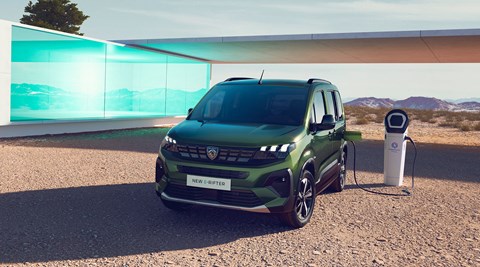
Pros: Great value prices, decent to drive, well equipped
Cons: Betrays its van roots, no longer a choice of fuels
The Peugeot e-Rifter is a bit of a gem, if you like the idea of a van-based people carrier. The genre pioneered by the Citroen Berlingo and Renault Kangoo all those years ago has now spawned an electric version with three rows of seats – and this is enough to qualify the e-Rifter as one of the best-value seven-seater EVs. Peugeot has in fact dropped the combustion models altogether, placing all its eggs in one basket.
It’s pleasingly functional with a handy sliding side door, but if you desire modish good looks or SUV swagger, we’d encourage you to look elsewhere on this list. However, if you value no-nonsense ability and family functionality, the e-Rifter makes a good argument for itself. Especially since the latest 2024 model now boosts the electric range to a more useable 199 miles, with 0-80 per cent charging taking a reasonable 30 minutes.
Tesla Model X
Best for: those who want to make a statement with a bit of Tesla magic
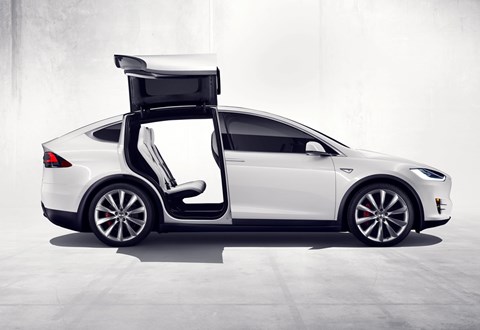
Pros: Incredibly fast, long-range, fancy doors
Cons: The fancy handclap doors break, LHD only – only available from stock
Tesla took a different approach when it designed its seven-seater electric car, the Model X. Rather than building a square box and filling it with seats, it took the same swoopy silhouette as the Model S saloon, jacked it up on tall suspension and fitted a pair of ‘look at me’ vertically opening Falcon Wing rear doors. As you can probably guess from that, the rear row is among the most useless of all here, but the power of the Tesla brand is hard to ignore. For some people, if you want to go electric, this is the only way, thanks to the clear image, minimalist, high-tech interior and sensational performance. Certainly, it’s hard to ignore the specs, even if it’s not massively practical.
Tesla no longer sells new RHD Model Xs in the UK, so you’ll either have to buy a pre-ordered left-hand-drive Model X, which will prove inconvenient, or buy a used one instead. Buy the entry-level Dual Motor variant, and you’ll get a maximum range of 358 miles and a 0-60mph time of 3.8 seconds. Opt for the flagship 1020bhp (!) Plaid model and the sprint time drops to a supercar-slaying 2.5 seconds – and you’ll still be able to travel more than 300 miles on a single charge. The Tesla charging network is substantial and impressive, too. Used examples cost from around £20k, too. It’s worth noting that Tesla will soon be introducing a seven-seat version of its popular Model Y, too.
For a more in-depth look, read our full Tesla Model X review
Mercedes EQV
Best for: posh VIP airport shuttle services
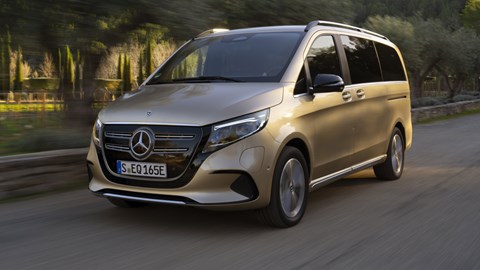
Pros: Loads of room inside, 200+ miles of driving range, genuinely luxurious
Cons: Neither fast to drive nor charge, more than double the cost of the equivalent Vauxhall
The Mercedes-Benz EQV is exactly what it looks like: a posh electric van with windows. It’s fundamentally based on the Vito commercial vehicle but is really the electrified version of the much fancier Mercedes V-Class. The seven-seater EQV keeps all the V-Class trimmings but replaces the diesel engine and fuel tank with a 201bhp electric motor and a substantial 90kWh of useable battery capacity. Despite looking like a squared-off brick, that’s enough juice for a claimed WLTP driving range of 222 miles per charge, though the sheer size of the pack means it’ll take 45 minutes to go from 10 per cent to 80 per cent at the maximum 110kW DC charging speed.
Sure, it isn’t the fastest option on this list – but it is one of the most comfortable. It might not look like much on the outside, but on the inside the EQV is loaded with luxury touches such as leather-trimmed captain’s chairs, electrically operated sliding doors, pillowy air suspension and a Burmester sound system. But the downside is the price, as it starts from a steep £92,000.
Read more about the Mercedes-Benz EQV
Volkswagen ID. Buzz LWB
Best for: being able to seat seven adults with ease – and, of course, its styling
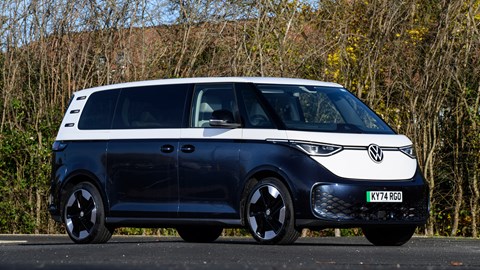
Pros: A seven-seater electric car with retro looks, good to drive, room for seven adults
Cons: Surprisingly impractical boot, bouncy ride
The long-wheelbase (LWB) VW ID. Buzz increases the seat count from the standard model’s five to the seven chairs requisite for this list. It also gets a bigger 86kWh battery, which increases the driving range to a claimed 291 miles, but expect 230 miles in real-world driving. A 335bhp GTX model is also available, reducing the 0-62mph to just 6.4sec. That’s as fast as a manual-gearbox Golf GTI! Not bad for a big, retro-styled brick, even if it’s a rather pointless addition considering the standard Buzz drives so well.
When it comes to outright passenger space, the ID.Buzz LWB excels, with room for seven adults in comfort thanks to its huge interior. But it’s perhaps not quite as The ID. Buzz could be more practical, though – there are no individual chairs in the back of this, and you can’t even get three child seats across the middle row. But when it comes to style it’s got everything else on this list thoroughly beaten, and it’s arguably the best of all of the Volkswagen ID electric cars available so far. The pricing could sting a bit, but perhaps not as much as the EQV’s…
For a more in-depth look, read our full Volkswagen ID. Buzz review
Volvo EX90
Best for: carrying your family in the utmost comfort and refinement
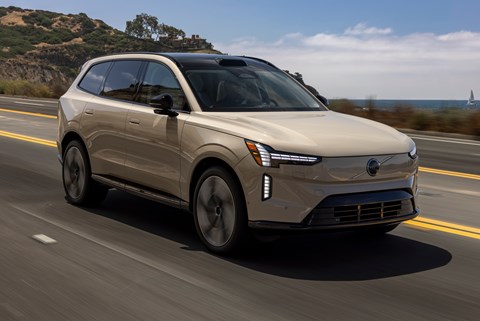
Pros: Exceptional refinement, very comfortable, big electric range
Cons: Frightening price, software still needs work
The Volvo XC90 has proven over the past two decades that this Swedish firm knows how to produce a top-tier seven-seat family car, and Volvo is now looking to conquer the electric car market with its new EX90. This flagship EV has been a long time coming, but it finally looks like it’ll land in the UK in early 2025. We’ve already driven it in the States and have been seriously impressed by its outstanding refinement and comfortable ride, which could be ideal for long journeys and holidays – Volvo claiming up to 374 miles.
The EX90 uses brand-new underpinnings shared with the Polestar 3, bringing significant advancements when it comes to crash-preventing safety technology and is designed to serve as a technology trailblazer for this firm. We still have question marks on the software from our experiences so far, and because, at launch, the EX90 is only available in a flagship guise, prices start from an eye-watering £96,000.
For a more in-depth look, read our full Volvo EX90 review
Peugeot e-5008
Best for: A stylish seven-seat SUV available at a good price
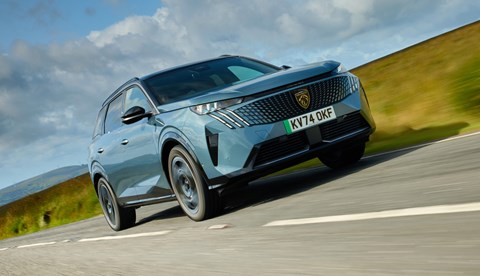
Pros: Huge electric range, cool-looking interior, comfortable ride
Cons: Cramped third row, interior ergonomics could be much better
Peugeot’s new-generation 5008 is the first that’s been sold as an electric model, and represents a sizeable step forward compared to its predecessor – and is a much bigger car than before, too. Seven seats are standard, with the e-5008 impressively having the same amount of interior space as the matching petrol car it’s sold alongside. There are roomier seven-seat SUVs than this Peugeot, but none more so at this price, which still has a decent amount of space in all rows, but the third row is best reserved for children.
Peugeot sells the e-5008 with a 73kWh battery as standard, or as Long Range model equipped with a huge 97kWh pack. The claimed range of each is 339 and 415 miles respectively, with the latter being one of the longest of any electric car on sale today. The e-5008 looks very stylish inside and out, though the cabin is a case of style over substance as the ergonomics take some time to get used to.
For a more in-depth look, read our full Peugeot e-5008 review
Seven seater electric cars buyer’s guide
The pros and cons of seven-seat electric cars
Getting a seven-seater electric car or van makes an increasing amount of sense these days, for those with large families, due to the rise in emissions-controlled areas. They are also ideal for average families with lots of friends and plenty of luggage to cart around – providing they don’t need to travel the length of the country in one go.
As with all EVs, though, it’s important to make sure you can live with their limitations. Make sure you have somewhere convenient to charge it before you buy and weigh up whether the EV’s maximum driving range is sufficient for your daily driving needs. Otherwise, you could end up buying a very expensive headache. That said, with the Peugeot e-5008’s range of more than 400 miles (claimed), it’s becoming less of an issue. Check out our guide on the benefits of electric cars to find out more about living with an EV day-to-day.
Also, unless your rationale for going electric is purely ethical, think about whether the running costs versus a petrol or diesel car will make the higher purchase price of an EV worthwhile for you. We also have a list of the best seven-seater cars with conventional petrol or diesel engines.

If you decide you really don’t need seven seats, or the sheer amount of space on offer from these vehicles, take a look at our list of the best electric cars on sale in the UK in 2025. Many are ideal for family life, and will serve up the zero-emissions motoring you’re looking for with other perks.
Which 7-seater electric car has the most room?
If it’s maximum space you’re after, then you’ll be needing one of the van-based models. Cream of the crop is the Mercedes EQV or Volkswagen ID.Buzz LWB, but the Vauxhall Vivaro Life Electric and its cousins offer similar space for much less money while the Peugeot e-Rifter and its relations do well for space versus compact size.
Which 7-seater electric car has the longest range?
If distance is more important to you than outright passenger space, the Peugeot e-5008 Long Range will go further than any other seven-seat EV, with a claimed distance of up to 415 miles.
The Volvo EX90 and Kia EV9 aren’t too far behind, with claimed ranges of 374 and 349 miles respectively.
What is the cheapest 7-seater car in the UK?
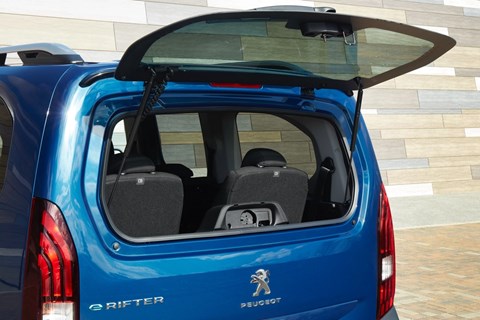
The lowest-price EV with seven seats in 2025 is the Peugeot e-Rifter, priced from £32k. Don’t forget you can search for secondhand examples on our sister site Parkers, whose buying tools and filters allow you to shop for 7-seaters by powertrain.
What upcoming electric seven-seaters should I look out for?
We’re constantly updating this guide to take into account new launches. Plenty of new seven-seat EVs have gone on sale already, but lots more are in the pipeline. Key new models to look out for include a new seven-seat version of the Tesla Model Y and the Hyundai Ioniq 9, which will serve as the brand’s flagship.
How we tested
CAR magazine has been rigorously testing cars since 1962: our team of experts never pull their punches and have been testing electric cars for decades. They have road-tested every car on this list, meaning that you can trust their judgments – giving you the confidence to make a well-informed purchase decision in the showroom.